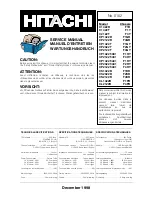
15
Horizontal and Vertical Deflection
In addition to decoding and switching, I501 provides deflection processing for the horizontal and vertical
time-base circuits. Using video from the IF or external source as appropriate, the timebase circuit of I501
produces horizontal drive pulses at pin 40 to switch horizontal drive transistor Q402, and a differential vertical
ramp at pins 46 and 47 to drive the vertical deflection output amplifier (I401).
All geometry adjustments are performed via the I²C bus with the service parameters (See adjustments
section) with the exceptions of picture width (which is fine tuned by adjusting the B+ voltage by means of
R818) and horizontal linearity (which is fixed by L402.)
Line Circuit
The primary side of the line circuit and the deflection coil are connected to the hot earth. The driver circuit
contains an opto-coupler to create isolation between the low signal parts and the mains. The opto-coupler is
driven by pin 40 of I501 via transistor Q402.
When Q402 is not conducting, the LED of the opto-coupler is also out of conduction, and Q403 is also not
conducting. In this way, Q404 will conduct and the B+ voltage (100V) is placed across winding 2-1 of the line
output transformer (T401). A voltage across winding 2-1 of the line output transformer (T401) will cause a
voltage across the windings 6- 9, 7- 9, 8- 9 and 10- 9. Energy is now transformed from the primary to the
secondary side and charges capacitors C407 (+200V video supply), C408 (+13V field supply) and C409 (-
13V field supply).
When transistor Q402 conducts, the LED of the opto-coupler is activated. This causes the transistor of the
opto-coupler to conduct, which drives Q403 into conduction. This brings Q404 out of conduction. Due to this
configuration, this circuit is protected against missing line-drive pulses. When a line-drive pulse is missed,
the line output transistor (Q404) stays out of conduction, because the LED of the opto-coupler is forced into
conduction by Q402 and R405 and R406. By this means, damage is avoided when there is no line drive.
The line output transistor Q404 is helped in its switching action by the extra winding 2-3 while C412 helps in
the switching action and prevents Q404 overheating.
C418 prevents Q404 from switching at twice line frequency. Line jitter is reduced by capacitor C417 in the
collector of Q402.
On the secondary side of the line output transformer (T401) there is a blanking circuit which consists of C749
and R734, D501, D502 and D503. As Q404 switches off this circuit sends a pulse to pin 41 of I501 via R532
to blank the picture.
Horizontal Deflection
The voltage across capacitor C809 is the same as the voltage between B+ and the hot earth. (100V) When
Q404 is conducting, this voltage is placed across the horizontal deflection coil via C411 and L402. This
causes a linearly increasing current through this coil, thus creating horizontal deflection. When Q404
switches off, horizontal flyback takes place and then horizontal deflection is repeated and so on. C411 and
L402 are used for linearity correction.
Vertical Deflection
Vertical deflection is based on a balanced input amplifier I401 connected to the +13V supply and -13V
supply. This is driven from pins 46 and 47 of I501 via R407 and R408. A negative going ramp at field rate
from I501 pin 46 is used to control I401. When the ramp is at its highest point, vertical flyback is generated
at I401 output (pin 5) by means of C403 and D411 and a flyback generator internal to I401. After vertical
flyback, the I401 output generates a negative going ramp across the field deflection coil which provides
deflection until the next flyback pulse and so on. R413 is used to damp oscillation of the field deflection coil.
Vertical deflection amplifier stability against self oscillation is maintained by R412, C404 and C402.
















































